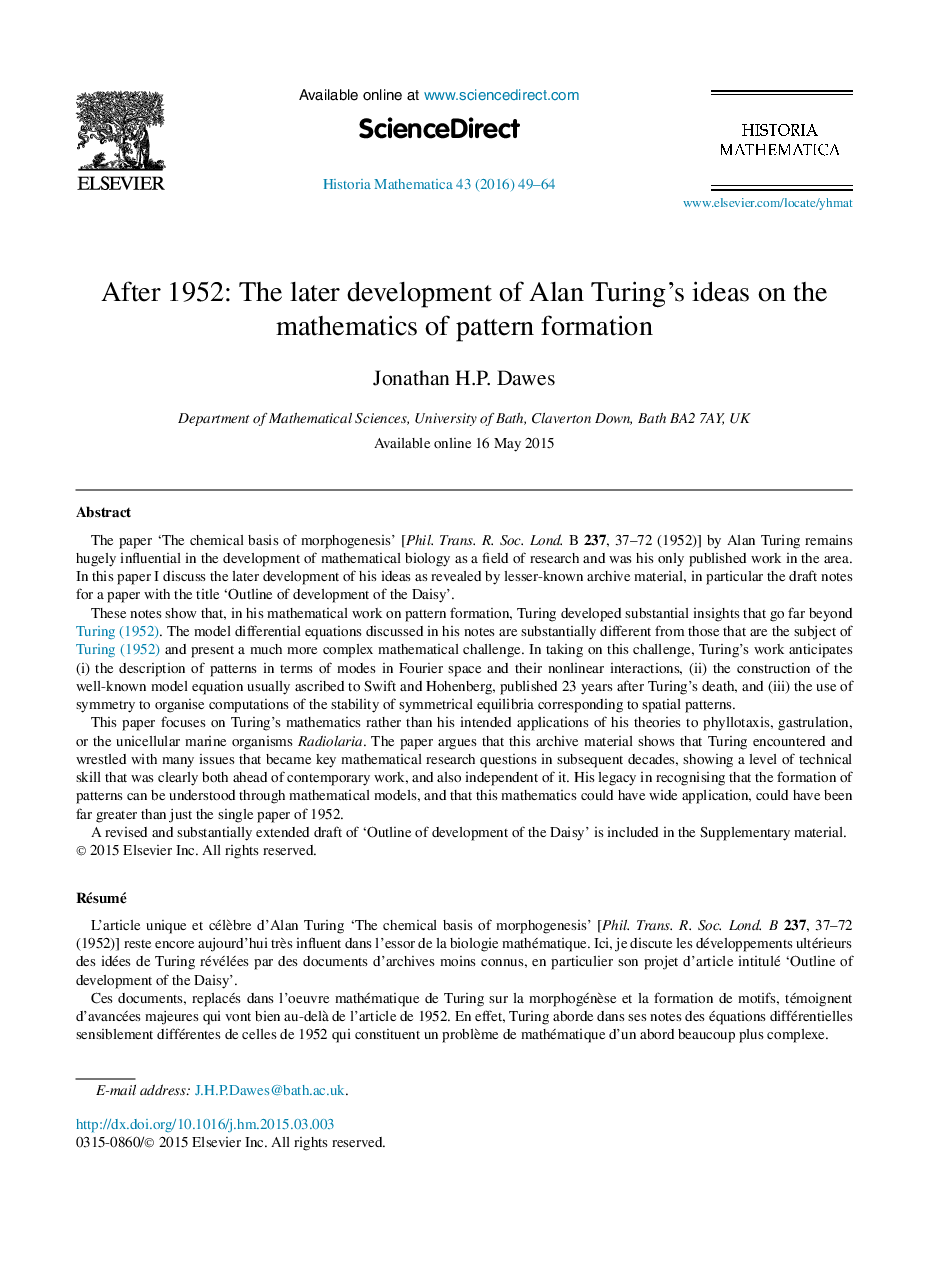| Article ID | Journal | Published Year | Pages | File Type |
|---|---|---|---|---|
| 1158289 | Historia Mathematica | 2016 | 16 Pages |
The paper ‘The chemical basis of morphogenesis’ [Phil. Trans. R. Soc. Lond. B 237, 37–72 (1952)] by Alan Turing remains hugely influential in the development of mathematical biology as a field of research and was his only published work in the area. In this paper I discuss the later development of his ideas as revealed by lesser-known archive material, in particular the draft notes for a paper with the title ‘Outline of development of the Daisy’.These notes show that, in his mathematical work on pattern formation, Turing developed substantial insights that go far beyond Turing (1952). The model differential equations discussed in his notes are substantially different from those that are the subject of Turing (1952) and present a much more complex mathematical challenge. In taking on this challenge, Turing's work anticipates (i) the description of patterns in terms of modes in Fourier space and their nonlinear interactions, (ii) the construction of the well-known model equation usually ascribed to Swift and Hohenberg, published 23 years after Turing's death, and (iii) the use of symmetry to organise computations of the stability of symmetrical equilibria corresponding to spatial patterns.This paper focuses on Turing's mathematics rather than his intended applications of his theories to phyllotaxis, gastrulation, or the unicellular marine organisms Radiolaria. The paper argues that this archive material shows that Turing encountered and wrestled with many issues that became key mathematical research questions in subsequent decades, showing a level of technical skill that was clearly both ahead of contemporary work, and also independent of it. His legacy in recognising that the formation of patterns can be understood through mathematical models, and that this mathematics could have wide application, could have been far greater than just the single paper of 1952.A revised and substantially extended draft of ‘Outline of development of the Daisy’ is included in the Supplementary material.
RésuméL'article unique et célèbre d'Alan Turing ‘The chemical basis of morphogenesis’ [Phil. Trans. R. Soc. Lond. B237, 37–72 (1952)] reste encore aujourd'hui très influent dans l'essor de la biologie mathématique. Ici, je discute les développements ultérieurs des idées de Turing révélées par des documents d'archives moins connus, en particulier son projet d'article intitulé ‘Outline of development of the Daisy’.Ces documents, replacés dans l'oeuvre mathématique de Turing sur la morphogénèse et la formation de motifs, témoignent d'avancées majeures qui vont bien au-delà de l'article de 1952. En effet, Turing aborde dans ses notes des équations différentielles sensiblement différentes de celles de 1952 qui constituent un problème de mathématique d'un abord beaucoup plus complexe.Embrassant ce défi, Turing propose (i) une description des motifs réguliers sous la forme de modes de Fourier et de leurs intéractions non-linéaires, (ii) la construction de l'équation modèle bien connue de Swift et Hohenberg, publiée 23 ans après la mort de Turing, et enfin (iii) l'utilisation des propriétés de symétrie de ces équations d'évolution afin d'organiser et de simplifier les calculs nécessaires à l'étude de stabilité des équilibres symétriques correspondant aux motifs spatiaux.Dans cet article, l'accent est porté sur les mathématiques de Turing et non sur les applications de ses théories à la phyllotaxie, la gastrulation, ou encore sur la morphogénèse des organismes marins unicellulaires comme les Radiolaria. On y montre en particulier que Turing s'est confronté à de nombreux problèmes ardus qui sont devenus dans les décennies suivantes des questions majeures en recherche mathématique, ce qui démontre une fois de plus un niveau de compétence technique hors norme qui était clairement à la fois bien en avance sur son temps, mais aussi indépendant de celui-ci. En reconnaissant que la formation de motifs peut se comprendre grâce à des modèles mathématiques, aux vastes champs d'application, il est évident que l'héritage de Turing aurait pu être beaucoup plus important que celui de son papier de 1952.Une reproduction sensiblement révisée et complétée de son ébauche d'article ‘Outline of development of the Daisy’ est incluse en annexe.
